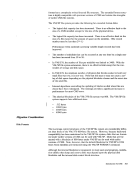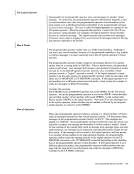Dedicated Channels
Spooling Functions
In most cases, the I/O devices and control units on a channel are shared among
many virtual machines as minidisks and dedicated devices, and shared withCP sys
tem functions such as paging and spooling. Because of this sharing,CP has to
schedule all the I/O requests to achieve a balance between virtual machines. In
addition,CP must reflect the results of the subsequent I/O interruption to the
appropriate storage areas of each virtual machine.
By specifying a dedicated channel (or channels) for a virtual machine via the Class
B ATTACH CHANNEL command, theCP channel scheduling function is
bypassed for that virtual machine. A virtual machine assigned a dedicated channel
has that channel and all of its devices for its own exclusive use.CP translates the
virtual storage locations specified in channel commands to reallocations and per
forms any necessary paging operations, but does not perform any device address
translations. The virtual device addresses on the dedicated channel must match the
real device addresses; thus, a minidisk cannot be used.
A virtual unit record device, which is mapped directly to a rea] unit record device, is
said to be dedicated. The real device is then controlled completely by the virtual
machine's operating system.CP facilities allow multiple virtual machines to share unit record devices. Since vir
tual machines controlled byCMS ordinarily have modest requirements for unit
record input/output devices, such device sharing is advantageous, and it is the
standard mode of system operation.
Spooling operations cease if the direct access storage space assigned to spooling is
depleted, and the virtual unit record devices appear in a not-ready status. The sys
tem operator or the spooling operator may make additional spooling space available
by purging existing spool files or by assigning additional direct access storage space
to the spooling function. The spooling operator can use the class DSPT APE com
mand to retrieve spool files from tape for output processing when spooling space
requirements are not critical.See the description of the SPT APE command in the
VM /SP Operator's Guide for further information.
Specific files can be transferred from the spooled card punch or printer of a virtual
machine to the card reader of the same or another virtual machine. Files trans
ferred between virtual unit record devices by the spooling routines are not phys
ically punched or printed. With this method, files can be made available to multiple
virtual machines, or to different operating systems executing at different times in
the same virtual machine.
Files may also be spooled to remote stations via the Remote Spooling Communi
cations Subsystem(RSCS), a program product of VM/SP. CP spooling includes many desirable options for the virtual machine user and the
real machine operator. These options include printing multiple copies of a single
spool file, backspacing any number of printer pages, and defining spooling ,classes
for the scheduling of real output. Each output spool file has, associated with it, a
136-byte area known as the spool file tag. The information contained in this area
and its syntax are determined by the originator and receiver of the file. For exam
ple, whenever an output spool file is destined for transmission to a remote location
VM/SP 11
Spooling Functions
In most cases, the I/O devices and control units on a channel are shared among
many virtual machines as minidisks and dedicated devices, and shared with
tem functions such as paging and spooling. Because of this sharing,
schedule all the I/O requests to achieve a balance between virtual machines. In
addition,
appropriate storage areas of each virtual machine.
By specifying a dedicated channel (or channels) for a virtual machine via the Class
B ATTACH CHANNEL command, the
bypassed for that virtual machine. A virtual machine assigned a dedicated channel
has that channel and all of its devices for its own exclusive use.
virtual storage locations specified in channel commands to reallocations and per
forms any necessary paging operations, but does not perform any device address
translations. The virtual device addresses on the dedicated channel must match the
real device addresses; thus, a minidisk cannot be used.
A virtual unit record device, which is mapped directly to a rea] unit record device, is
said to be dedicated. The real device is then controlled completely by the virtual
machine's operating system.
tual machines controlled by
record input/output devices, such device sharing is advantageous, and it is the
standard mode of system operation.
Spooling operations cease if the direct access storage space assigned to spooling is
depleted, and the virtual unit record devices appear in a not-ready status. The sys
tem operator or the spooling operator may make additional spooling space available
by purging existing spool files or by assigning additional direct access storage space
to the spooling function. The spooling operator can use the class D
mand to retrieve spool files from tape for output processing when spooling space
requirements are not critical.
VM /
Specific files can be transferred from the spooled card punch or printer of a virtual
machine to the card reader of the same or another virtual machine. Files trans
ferred between virtual unit record devices by the spooling routines are not phys
ically punched or printed. With this method, files can be made available to multiple
virtual machines, or to different operating systems executing at different times in
the same virtual machine.
Files may also be spooled to remote stations via the Remote Spooling Communi
cations Subsystem
real machine operator. These options include printing multiple copies of a single
spool file, backspacing any number of printer pages, and defining spooling ,classes
for the scheduling of real output. Each output spool file has, associated with it, a
136-byte area known as the spool file tag. The information contained in this area
and its syntax are determined by the originator and receiver of the file. For exam
ple, whenever an output spool file is destined for transmission to a remote location
VM/SP 11



































































































































































































































































































































































































































































































































































































































